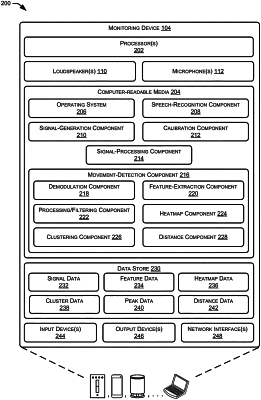| CPC G01S 13/56 (2013.01) [G01S 7/4056 (2013.01); G01S 13/581 (2013.01); G01S 13/584 (2013.01); G01S 13/84 (2013.01)] | 20 Claims |

|
1. A monitoring device comprising:
a loudspeaker;
one or more processors; and
one or more computer-readable media storing computer-executable instructions that, when executed by the one or more processors, cause the one or more processors to perform operations comprising:
causing the loudspeaker to emit, during a period of time, frequency-modulated continuous wave (FMCW) ultrasonic signals into an environment, a first FMCW ultrasonic signal having a first portion that increases in frequency in a frequency range and a second portion that decreases in frequency in the frequency range;
receiving reflection signals corresponding to the FMCW ultrasonic signals, the reflection signals originating at an object in motion;
generating, over a plurality of time frames, data including energy values corresponding to the reflection signals;
identifying, for a first time frame, a first energy value that corresponds to a first reflection of the first portion of the first FMCW ultrasonic signal, the first energy value being associated with a first distance;
identifying, for a second time frame adjacent the first time frame, a second energy value that corresponds to a second reflection of the second portion of the first FMCW ultrasonic signal, the second energy value being associated with a second distance;
calculating an average distance using the first distance and the second distance; and
determining, based at least in part on the average distance, distance data indicating a distance between the object and the monitoring device.
|